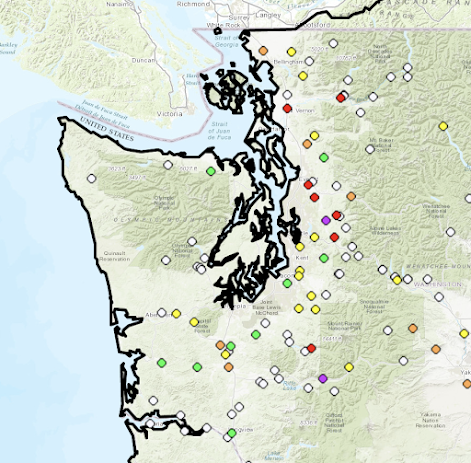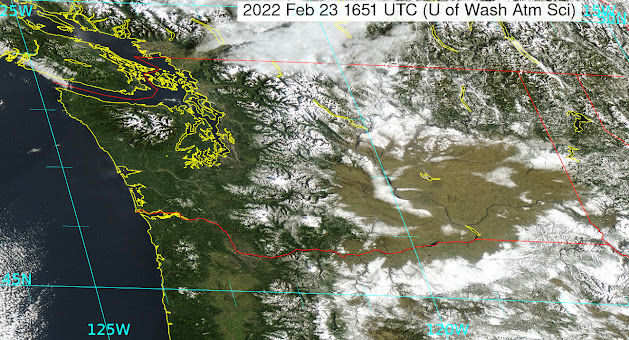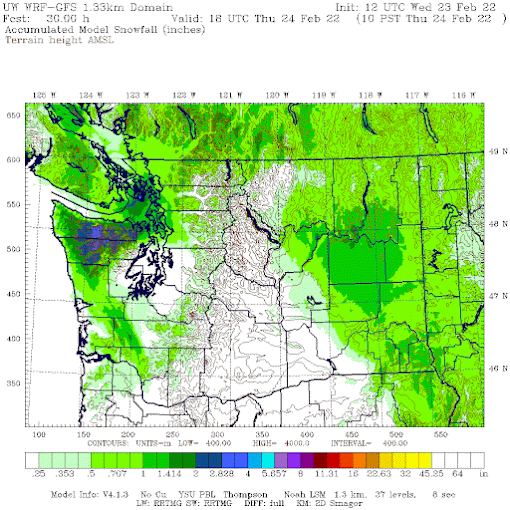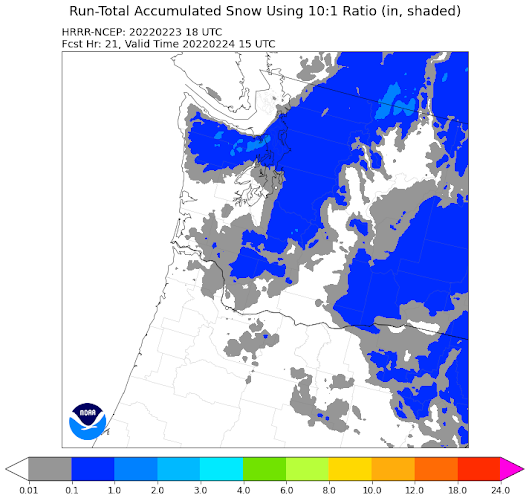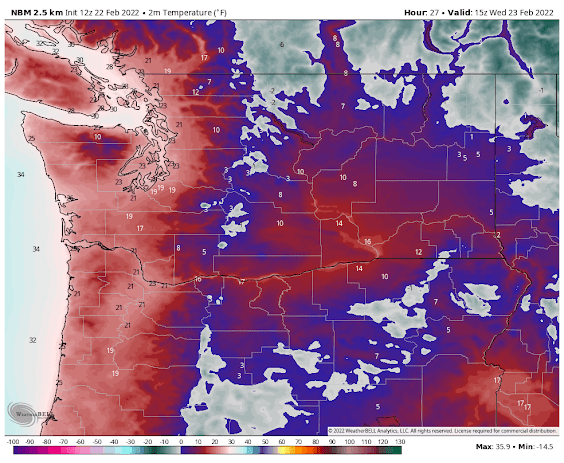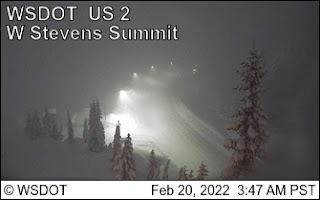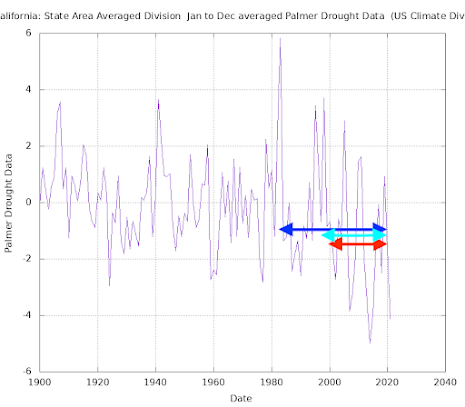During the past week, many major media websites have headlined a study by some UCLA researchers suggesting that the Southwest U.S. is in a megadrought--the worst in 1200 years-- and that global warming is the prime cause.
To illustrate, below is the front page of the LA Times. And the Seattle Times highlighted the megadrought claims as well.
Unfortunately, there are some major problems with this study and many of the hyperbolic claims--as I will explain below.
The US Southwest has clearly experienced a dry spell recently, but global warming (a.k.a. climate change) is only a minor contributor compared to natural variability. Decadal dry periods are not unusual or unknown for the U.S. Southwest. They have happened many times before during periods when human-caused climate change could not be the origin.
Why 22 years?
A key aspect of this paper is its claim that the last 22 years were the driest over the southwest U.S. for the past 1200 years. Their measure of dryness was soil moisture and they secured this indirectly by relating tree ring chronologies to such moisture. Here is a plot of soil moisture from their paper:
Figure 1b from Williams et al. 2002. Nature Climate Change. The soil moisture
is expressed as standard deviations from the mean.
Tree rings are, of course, imperfect measurements of soil moisture, but let's put that aside for the moment.
You will notice a lot of ups and down in southwest U.S. soil moisture, and that in most ways, the recent dry period is unremarkable. In fact, there were many previous events in which the soil moisture was drier. There were many periods when the soil moisture was low (say less than -1) for longer periods.
Now, I am not a little surprised that none of the "curious" media stopped for a moment and asked: why did these researchers pick 22 years? Why not 25 years, 30 years, or 50 years?
The answer is that their whole narrative, their whole claim of unusual drought, would have weakened greatly if they had used 25 years or 30 years or anything longer.
You can see the issue from the plot above. The soil moisture was in fact VERY HIGH during the 1990s, including 1998. If they had used a longer period, they would have found more normal conditions.
If you want to see this more clearly, let me show you the Palmer Drought Index over California during the past 120 years (see below). This index combines temperature and precipitation and is a reasonable thing to compare to their soil moisture index.
The 22 year period (red, -1.51)) has an average that is much lower than the past 30 years (blue -.93) or the past 25 years (cyan, -1.24). This effect is even larger if you look at precipitation. By selecting 22 years they avoided the wet period in the mid to late 1990s.
Now I am not comfortable with their approach, with claims of megadrought dependent on selecting the exact period over which it recently has been dry.
_________________________________________
Addition
A NOAA website just came up, and using it I have plotted the Palmer Drought Severity Index for the whole Southwest. I put a line on the year 2000. You will see that the Williams et al study selected the driest period for analysis...the optimally dry period, with a much wetter period preceding. Such a rapid transition is not the expected impact of global warming, which would tend to change temperature/moisture gradually.
_____________________________________
What is the origin of the two-decade dry period?
There is little doubt that it has been relatively (but not record) dry over the southwest U.S. during the past two decades. The authors of this paper claim it is mainly due to global warming, but there is strong evidence that this is not the case.
Something unusual has been going on during the past 20 years: persistent ridging (high pressure) during the winter over the northeastern Pacific. And such high pressure has kept storms away from the southwest U.S.
Several highly regarded atmospheric scientists have investigated this issue and have found that the persistent high pressure and associated warm sea surface temperatures off the West Coast are due to natural variability, not global warming. This (Johnstone and Mantua 2014) work has been published in the peer-reviewed literature (see one below).
To provide one quote from this excellent paper:
These results suggest that natural internally generated
changes in atmospheric circulation were the primary cause of coastal
NE Pacific warming from 1900 to 2012 and demonstrate more generally that regional mechanisms of interannual and multidecadal
temperature variability can also extend to century time scales.
Specifically, natural variability, like changes in the Pacific Decadal Oscillation, is what forced the unusually warm, dry conditions of the past 20 years, and there is no evidence that global warming is contributing.
The authors of the megadrought paper, for some reason, ignored the obvious role of natural variability but focused on output from global climate models (GCMs). Such climate models, forced by increasing greenhouse gases, simulated substantial warming during the past 20 years, drying the soils and thus leading to the author's claims that the 22-year megadrought was mainly the result of greenhouse gas emissions.
But there are substantial problems with such models and their application to this problem.
Climate models are known for their failure to properly simulate (or simulate at all) key modes of natural variability like the Pacific Decadal Oscillation. The particular models used in this work (CMIP-6) are well known to be overly sensitive to greenhouse gas concentrations. There are substantial problems with global climate model physics, such as their unphysical cloud coverage (something I am researching) and poor simulation of convection (thunderstorms). And there are many other known deficiencies. In addition, these models have been tuned to match the climate of the past century, which may undermine their ability to predict the future reliably.
In short, just because the climate models were producing warming over the southwest U.S. does not mean that increasing greenhouse gases were actually the cause, particularly when there is very good published science that suggests otherwise. Furthermore, the climate models have well-known major deficiencies.
In Summary
The southwest U.S. has always experienced periodic droughts that have extended over decades and the fact that this has occurred for thousands of years shows that global warming from increasing greenhouse gases is not the cause. This is part of the meteorology/climatology of the region.
We are in the midst of a dry period that is not particularly unusual in intensity and there is strong evidence that it is the result of natural variability.
The best science we have now suggests that increasing greenhouse gases will have uncertain effects on southwest U.S. precipitation during this century. Regarding temperatures, at this point in time, global warming effects are probably small compared to natural variability but will increase during this century as greenhouse gas emissions increase and the atmosphere and ocean slowly warm.
Announcement
I will be having a zoom session with Patreon supporters on Saturday at 10 AM.




